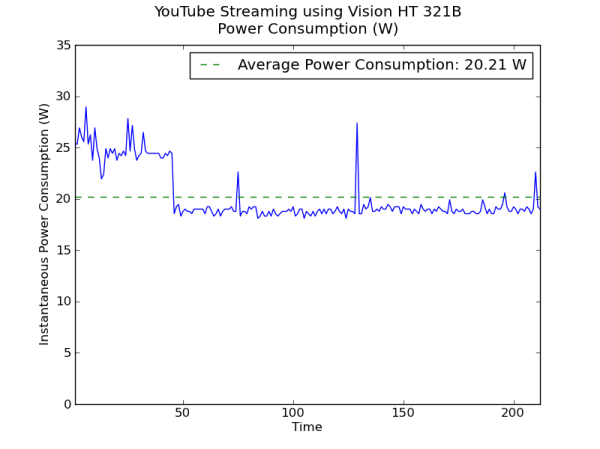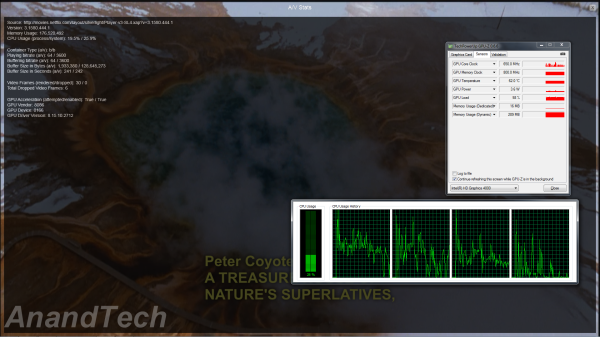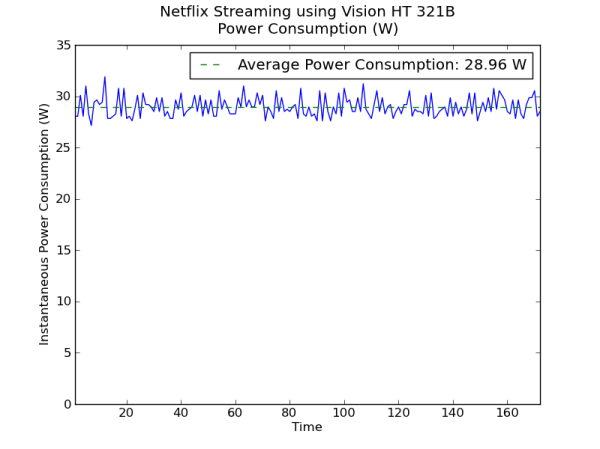ASRock Vision HT: Ivy Bridge Carries the SFF HTPC Forward
by Ganesh T S on November 12, 2012 3:30 PM EST- Posted in
- Home Theater
- ASRock
- HTPC
- Ivy Bridge
Networking Performance and Streaming Aspects
In this section, we will take a look at the networking capabilities of the unit and also our standard HTPC streaming tests (involving YouTube and Netflix). ASRock delivered dual-band Wi-Fi in the Vision HT 321B. The 5 GHz band is able to practically deliver more than double the throughput of the 2.4 GHz band when used with an appropriate router.
Dual Band Wi-Fi
We used Ixia's IxChariot to check the TCP throughput in the 2.4 and 5 GHz bands using Western Digital's MyNet N900 router with default settings. We tested at two locations, one right next to the router and the other across a wall, separated by around 30 ft. The gallery below shows the throughput graphs obtained. While the 2.4 GHz band is able to deliver around 65 Mbps real-world throughput, the 5 GHz band delivers around 160 Mbps.
Under these circumstances, it becomes possible to even stream uncompressed Blu-ray rips over the wireless network. Unlike 2.4 GHz, the 5 GHz band is not prone to interference. However, the range is smaller.
YouTube and Netflix Streaming
The drivers for the Intel HD 4000 enable hardware accelerated decode and rendering for both YouTube and Netflix streams in Flash and Silverlight respectively. Screenshots of our standard test streams in action are provided below. In addition, we are also providing power consumption graphs over time for the full YouTube clip and a segment of the Netflix clip.
Adobe Flash Hardware Acceleration (YouTube)
The power consumption graph for the YouTube clip above shows that the unit consumes more power in the beginning as the video is streamed over the Wi-Fi network, but, later, settles down to a lower value corresponding to the decode and rendering steps.
Hardware Acceleration for Netflix in Microsoft Silverlight
Unlike YouTube, Netflix doesn't seem to buffer the full movie during playback on a PC. After filling up a pre-determined buffer size, the download rate seems to throttle down to maintain it. The power consumption graph shows the unit's characteristics during playback with simultaneous download over Wi-Fi.


















40 Comments
View All Comments
shurik_1 - Monday, November 12, 2012 - link
Could you test the silent data corruption issue I have described in Vision 3D comments? With Vision 3D it is still an issue when 16GB RAM are installed (with 8GB RAM they fixed it via BIOS update that they did not make publicly available) and ASRock although acknowledges its existence refuses to fix it.ganeshts - Monday, November 12, 2012 - link
I will follow up on this with ASRock. That said, I have been using the Vision HT / Vision 3D 252B to unpack a number of split archives (around 400 MB each unpacking to ~4.37 GB / ~10 GB) and not found any issues so far.But, definitely an interesting case (if there is some data corruption with a different DRAM, that may point to some issue in the DRAM module itself). Are you aware of any other users with the same issue? I am trying to see if there is something common between all the systems exhibiting this problem...
shurik_1 - Monday, November 12, 2012 - link
It will not complain at unpack because my thinking is that corruption occur at writing (at some point in my lengthy mail exchange with ASRock support Intel ME was mentioned as the culprit). I discovered the issue because par repair invariably fails on large file sets. That is why I call it silent. Did you try to create checksum of archive content and test after unpack? I have only one set of laptop 16GB modules. But when my 2nd gen Vision 3D had BIOS prior to 1.10c ("c" suffix is important here) it was present with 16GB and two different sets of 8GB modules.klmccaughey - Monday, November 12, 2012 - link
I don't understand why manufacturers can't release a cheap HTPC. It is still much more cost effective to build your own.Every time I see one of these reviews I get excited, and every time I get disappointed as I see the outrageous price tag.
EnzoFX - Monday, November 12, 2012 - link
I too wish there were cheaper alternatives. I myself have no need for optical (Ew), and am usually eyeing those tiny foxconn's that use E-350's. Though I'd more likely go with something with more performance.Perhaps this segment is too much of a niche (Probably). Intel's NUC looks promising, hope it becomes standardized so that the race to the bottom can start on those chips =P.
lurker22 - Monday, November 12, 2012 - link
Avoid the 350. Yes it will work, but a lot of use end up being slow on it especially when the GPU acceleration isn't available.StealthX32 - Monday, November 12, 2012 - link
From what I've read on a few Newegg reviews, you can get a Broadcom BCM9700xx hardware decoder card to put into the miniPCI-e slot and achieve <20% CPU utilization on even high bitrate 1080p material.I bought this from them when they had the buy an HTPC get a free SSD combo, but haven't gotten around to buying the Broadcom card yet.
lurker22 - Monday, November 12, 2012 - link
As I said, it's doing everything outside of the GPU accelerated videos that ends up being very slow. Web browsing, Netflix, etc is all CPU limited.BuddyRich - Monday, November 12, 2012 - link
Netflix via website and silverlight is bad.Youtube HD is GPU accelerated and Netflix Win8 also works nicely.
One of the few pluses of Win8!
Pipperox - Tuesday, November 13, 2012 - link
I have an E-350 based Zotac Nano.It's absolutely silent, can play most media content without a hitch (haven't tried 1080p60 content though, but 24 and 30Hz are not a problem) and with Windows 8 internet browsing and general PC usage is butter smooth.
Sure, i wouldn't do media transcoding or rendering or content creation on such a PC, but for the value and intended use I couldn't be happier.